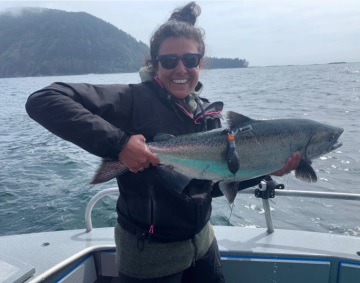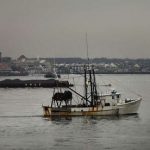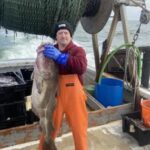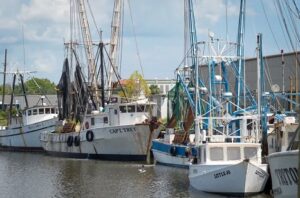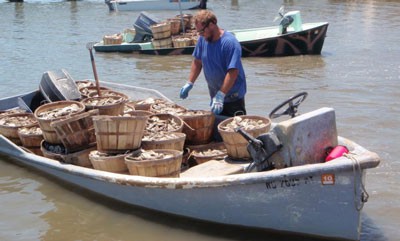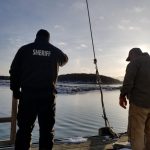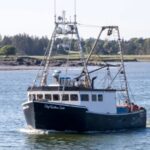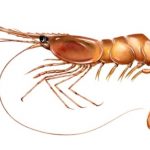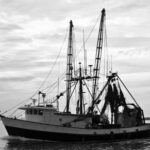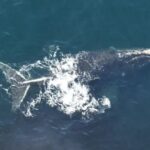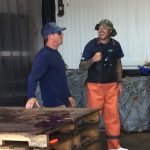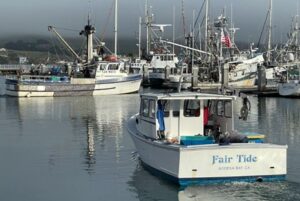Tag Archives: Chinook salmon
Alaska lawmakers, residents ask feds to limit how much salmon industrial trawlers catch
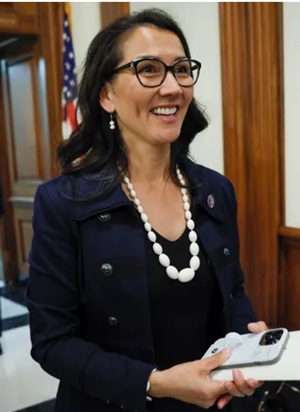 U.S. Rep. Mary Peltola, Alaskan Natives, and family-owned fisheries are looking for a sea change in the fishing rights battle between local fishermen and industrial trawling fishing operations after a federal council recently denied a tribe-approved reduction in chum salmon catches. In western Alaska, local communities are facing a significant decline in salmon populations. The cause of this decline remains a subject of intense debate between industry leaders, subsistence communities, conservation scientists, and local fishermen. Residents point to the Seattle-based trawler fleets in the Bering Sea fishing for pollock but unintentionally catching thousands of chum salmon as bycatch instead. more, >>CLICK TO READ<< 11:31
U.S. Rep. Mary Peltola, Alaskan Natives, and family-owned fisheries are looking for a sea change in the fishing rights battle between local fishermen and industrial trawling fishing operations after a federal council recently denied a tribe-approved reduction in chum salmon catches. In western Alaska, local communities are facing a significant decline in salmon populations. The cause of this decline remains a subject of intense debate between industry leaders, subsistence communities, conservation scientists, and local fishermen. Residents point to the Seattle-based trawler fleets in the Bering Sea fishing for pollock but unintentionally catching thousands of chum salmon as bycatch instead. more, >>CLICK TO READ<< 11:31
Yukon River Panel hears fishing moratorium on Yukon River chinook may be ‘too little, too late’
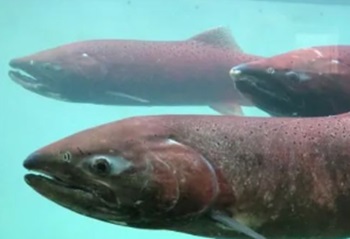 A new international agreement on chinook salmon stoked at times emotional debate at the Yukon River Panel meeting in Anchorage, Alaska, this week, and while many appeared to approve of the pact, others seemed to cast doubts. Duane Aucoin, a member of the Teslin Tlingit Council in the Yukon, said it’s taken the collapse of the chinook population to finally do something, but the natural world doesn’t work that way. “One thing we’re afraid of is, is this too little, too late?” he said. “Western policies, Western politics, Western science is what helped get us into this crisis, into this mess. Traditional knowledge will help get us out.” Photos, more, >>click to read<< 08:02
A new international agreement on chinook salmon stoked at times emotional debate at the Yukon River Panel meeting in Anchorage, Alaska, this week, and while many appeared to approve of the pact, others seemed to cast doubts. Duane Aucoin, a member of the Teslin Tlingit Council in the Yukon, said it’s taken the collapse of the chinook population to finally do something, but the natural world doesn’t work that way. “One thing we’re afraid of is, is this too little, too late?” he said. “Western policies, Western politics, Western science is what helped get us into this crisis, into this mess. Traditional knowledge will help get us out.” Photos, more, >>click to read<< 08:02
Press Democrat Editorial: North Coast fishers need help
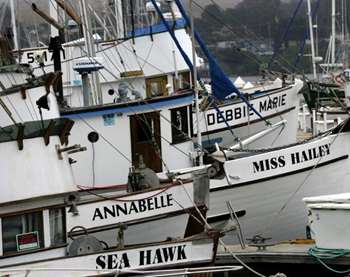 The bad news keeps piling up for the North Coast’s beleaguered fishing industry. Crab season was delayed yet again this winter, and now salmon season may be canceled entirely for the second consecutive year. Even a hopeful development — the ongoing removal of four obsolete hydroelectric dams on the Klamath River — turned sour when as many as 830,000 hatchery fish died within days after being released in the Klamath, apparently because of high water pressure inside a bypass tunnel at Iron Gate Dam. Commercial and sport fishing have supported families in Bodega Bay, Fort Bragg and other North Coast towns for generations. “The identity of Bodega Bay is fishing,” Dick Ogg, a local skipper and president of the Bodega Bay Fisherman’s Marketing Association, told the editorial board. “The town itself, that is what we are, fishermen.” more, >>click to read<< 07:01
The bad news keeps piling up for the North Coast’s beleaguered fishing industry. Crab season was delayed yet again this winter, and now salmon season may be canceled entirely for the second consecutive year. Even a hopeful development — the ongoing removal of four obsolete hydroelectric dams on the Klamath River — turned sour when as many as 830,000 hatchery fish died within days after being released in the Klamath, apparently because of high water pressure inside a bypass tunnel at Iron Gate Dam. Commercial and sport fishing have supported families in Bodega Bay, Fort Bragg and other North Coast towns for generations. “The identity of Bodega Bay is fishing,” Dick Ogg, a local skipper and president of the Bodega Bay Fisherman’s Marketing Association, told the editorial board. “The town itself, that is what we are, fishermen.” more, >>click to read<< 07:01
Unalaska pushes back against proposed bycatch restrictions on pollock fishery
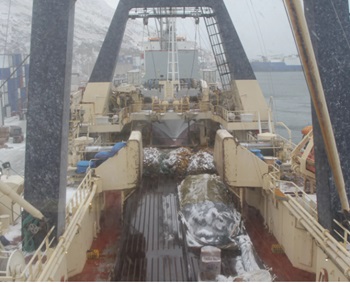 Unalaska leaders are pushing back against a proposed petition to eliminate Chinook bycatch in the Bering Sea Alaska pollock fishery. Nearly 100 tribes and communities in western Alaska, including the Association of Village Council Presidents, signed an emergency petition that would set a zero-bycatch limit on Chinook salmon in the pollock trawl fishery for 180 days. Unalaska Mayor Vince Tutiakoff Sr. said in a letter that a zero-cap would “effectively shut down the entire pollock fishery of the Bering Sea,” and create a “dire situation” for Unalaska. links, more, ??click to read<< 11:19
Unalaska leaders are pushing back against a proposed petition to eliminate Chinook bycatch in the Bering Sea Alaska pollock fishery. Nearly 100 tribes and communities in western Alaska, including the Association of Village Council Presidents, signed an emergency petition that would set a zero-bycatch limit on Chinook salmon in the pollock trawl fishery for 180 days. Unalaska Mayor Vince Tutiakoff Sr. said in a letter that a zero-cap would “effectively shut down the entire pollock fishery of the Bering Sea,” and create a “dire situation” for Unalaska. links, more, ??click to read<< 11:19
Fishing advocates say California salmon disaster fund is too low
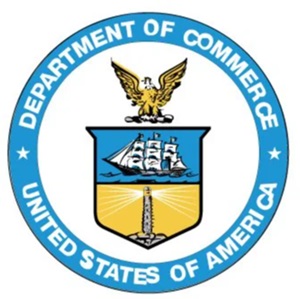 The $20.6 million allocated for federal relief for California’s Chinook salmon stocking is only two-thirds of the state’s aid request, and threatens the existence of fishing businesses, California commercial fishermen and rental recreational groups said, on Monday. In a letter to U.S. Commerce Department Secretary Gina Raimondo, the Pacific Coast Federation of Fishermen’s Association, the Golden Gate Fishermen’s Association and the Northern California Guides and Sportsmen’s Association called for “immediate full funding of salmon disaster funding assistance” at $30.7 million. Data sought by state officials. “The state’s economic analysis already falls short of expected needs, and the federal disaster aid package adds insult to injury,” fishing group leaders wrote in their joint letter. more, >>click to read<< 08:56
The $20.6 million allocated for federal relief for California’s Chinook salmon stocking is only two-thirds of the state’s aid request, and threatens the existence of fishing businesses, California commercial fishermen and rental recreational groups said, on Monday. In a letter to U.S. Commerce Department Secretary Gina Raimondo, the Pacific Coast Federation of Fishermen’s Association, the Golden Gate Fishermen’s Association and the Northern California Guides and Sportsmen’s Association called for “immediate full funding of salmon disaster funding assistance” at $30.7 million. Data sought by state officials. “The state’s economic analysis already falls short of expected needs, and the federal disaster aid package adds insult to injury,” fishing group leaders wrote in their joint letter. more, >>click to read<< 08:56
California’s Central Valley Chinook Are Getting Lost on Their Way Home
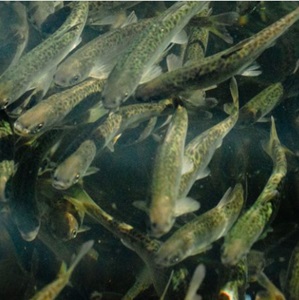 Picture yourself: a chinook salmon in the prime of your life. You dart through the water off California’s central coast, winding through kelp and dodging hungry sea lions. Long, sleek and silver, dappled with dark spots. Eyes wide and vigilant. More than 20 kilograms of pure muscle. You’ve been out at sea for several years now, first voyaging north along the Oregon coastline, then westward into deeper water. As winter approaches and the days grow shorter, you’ve found your way back to California. You’ve felt the seasons turn before, but this year, it means something special. Your kind, the Central Valley chinook—what fishers call the king salmon—are not born at sea. For thousands of years, your ancestors began their lives in the heart of California, where tributaries and streams flow together to form the mighty Sacramento and San Joaquin Rivers. photos, >>click to read<< 08:31
Picture yourself: a chinook salmon in the prime of your life. You dart through the water off California’s central coast, winding through kelp and dodging hungry sea lions. Long, sleek and silver, dappled with dark spots. Eyes wide and vigilant. More than 20 kilograms of pure muscle. You’ve been out at sea for several years now, first voyaging north along the Oregon coastline, then westward into deeper water. As winter approaches and the days grow shorter, you’ve found your way back to California. You’ve felt the seasons turn before, but this year, it means something special. Your kind, the Central Valley chinook—what fishers call the king salmon—are not born at sea. For thousands of years, your ancestors began their lives in the heart of California, where tributaries and streams flow together to form the mighty Sacramento and San Joaquin Rivers. photos, >>click to read<< 08:31
The Fish Shop brings Oregon fish to Corvallis
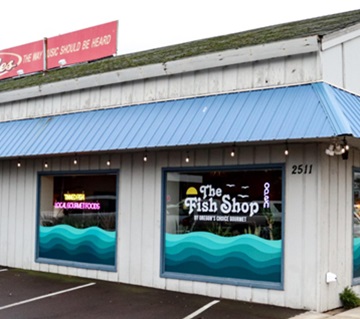 Prior to the store’s opening, Harrison’s brand, Oregon’s Choice was solely online, selling primarily albacore tuna and Chinook salmon, all caught and canned in Oregon. Harrison purchased Oregon’s Choice from her parents in 2020, and in doing so happened upon the perfect market. “The two best businesses to be in 2020 were toilet paper and canned food,” Harrison said, alluding to the COVID-19 pandemic. The business started in 1977 with Harrison’s father, Herb Goblirsch selling his catch on the docks of Newport. >>click to read<< 08:37
Prior to the store’s opening, Harrison’s brand, Oregon’s Choice was solely online, selling primarily albacore tuna and Chinook salmon, all caught and canned in Oregon. Harrison purchased Oregon’s Choice from her parents in 2020, and in doing so happened upon the perfect market. “The two best businesses to be in 2020 were toilet paper and canned food,” Harrison said, alluding to the COVID-19 pandemic. The business started in 1977 with Harrison’s father, Herb Goblirsch selling his catch on the docks of Newport. >>click to read<< 08:37
Salmon fall run in Mokelumne River sets 80-year record
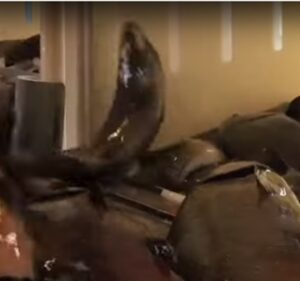 More fall-run Chinook salmon are returning to spawn in the Mokelumne River this year than in any year since 1940, when wildlife officials first began tracking the population, according to the East Bay Municipal Utility District. EBMUD officials announced Thursday that more than 20,000 fish have so far returned to the river to complete their life cycle. “This year’s historic return highlights EBMUD’s longstanding collaboration in the region and our deep commitment to sustaining this vital fish hatchery and protecting the river’s habitat,” said EBMUD board president Andy Katz. Video, >>click to read<< 09:36
More fall-run Chinook salmon are returning to spawn in the Mokelumne River this year than in any year since 1940, when wildlife officials first began tracking the population, according to the East Bay Municipal Utility District. EBMUD officials announced Thursday that more than 20,000 fish have so far returned to the river to complete their life cycle. “This year’s historic return highlights EBMUD’s longstanding collaboration in the region and our deep commitment to sustaining this vital fish hatchery and protecting the river’s habitat,” said EBMUD board president Andy Katz. Video, >>click to read<< 09:36

Oregon fishing disaster declared after failure impacting Chinook Salmon
Oregon Gov. Tina Kotek announced Friday that a fishing disaster has been declared following a three-year commercial fishery failure in the state. The declaration comes after U.S. Secretary of Commerce Gina Raimondo determined that a commercial fishery failure occurred in 2018, 2019 and 2020 because of a fishery resource disaster impacting Oregon Chinook Salmon Fisheries, the governor said. The determination comes after a request from former Gov. Kate Brown in October 2021. Fisheries with disaster determinations are eligible for funding from fishery disaster appropriations to help with community recovery, fishery restoration and prevention of future disasters. >>click to read<< 17:00

Alaska Fish and Game announces closure of Chinook salmon commercial troll fishery at 11:59 p.m., Wednesday, July 12, 2023
The commercial troll fishery will close to the retention of Chinook salmon at 11:59 p.m., Wednesday, July 12, 2023. The current target harvest for the first Chinook salmon retention period of 77,100 Chinook salmon is expected to be reached by this time. All Chinook salmon must be offloaded prior to operating troll gear for other salmon species, according to the Fish and Game announcement. All processors and trollers are required to submit fish tickets to the department within seven days of landing. A freezer catcher–processor (FAS) that retains coho salmon onboard after the Chinook salmon fishery closure must,,, >click to read< 20:53

Chinook troll fishers in Southeast Alaska to put hooks in water July 1, but how many can they catch?
One day after the Ninth Circuit Court of Appeals overturned a Seattle judge’s ruling that had shut down the Southeast Alaska chinook troll fishery, the Alaska Department of Fish and Game delivered the catch limit news to the troll fishermen, specifying the number of kings they are allowed to catch during the upcoming season. Commercial trollers will have a total allocation of 74,800 chinook salmon during the first retention period, which begins July 1. Based on data from past years, the department thinks that the goal will be reached in 9-10 days, depending on weather. >click to read< 09:35
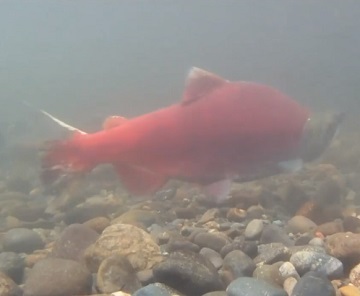
Fish from Washington’s coastal commercial troll Chinook fishery are a more sustainable way to eat salmon
Washington Fish and Wildlife (WDFW) says the coastal commercial troll Chinook fishery will begin May 1, and encourages customers to keep an eye out for locally caught salmon. It says the fishery is unique for both its economic and environmental impacts. “A lot of the people who hold troller permits are families that have been doing this for generations in Washington state,” WDFW Marine Salmon Fisheries Policy Coordinator Dr. Alexandrea Safiq said. Fisherman Geoff Lebon says trollers catch different stocks throughout the summer and pace their fishing to fit the market, keeping costs lower for customers. Video, >click to read< 09:47
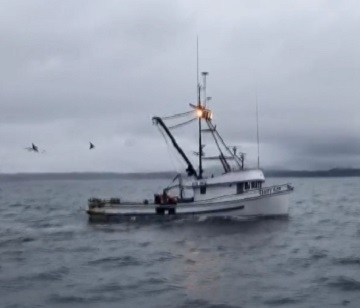
Imperiled Chinook salmon runs close ocean fishing off California, much of Oregon
The closure currently runs through May 15 and affects a length of the coast stretching from Oregon’s Cape Falcon, near Cannon Beach, south to the Mexican border. And it could be extended, officials said, as the imperiled species struggles amid a long-running drought. Further closures are likely, said Eric Schindler, head of the Oregon Department of Wildlife’s Ocean Salmon Program.“It doesn’t look good for this year or next year, and possibly the year after that, because of the drought conditions in California,” Schindler said. “We have to make sure that we’re not undermining our ability to produce salmon for the next go around.” Video, >click to read< 10:35

Lawsuit threatens to shut down Southeast salmon troll fishery
An ongoing lawsuit by a Washington State environmental group is threatening to shut down the Southeast Alaska salmon troll fishery in the summer and winter to help endangered Puget Sound orca whales, and has prompted the trollers to ask the City of Sitka to help pony up for legal bills. The Seattle-based group Wild Fish Conservancy filed suit last year and a federal court ruled last August that the National Marine Fisheries Service had violated the Endangered Species Act and the National Environmental Policy Act in approving salmon harvests in the Southeast troll fishery, which catches chinook salmon, a key food source for the Puget Sound orcas. In the meantime, lawsuits and rulings are continuing. >click to read< 08:36

Sea lions, seals might be hampering WA salmon recovery. What can be done?
State officials are now exploring whether to kill sea lions and seals in the Salish Sea and outer coast in a desperate effort to save salmon species from extinction. A new report commissioned by the state Legislature and completed by the Washington Academy of the Sciences says seals and sea lions are likely impeding salmon recovery, and the full impacts of predation on salmon may not be fully understood without lethal intervention. Three mammals specifically have skyrocketed. From 1975 to 2015, the harbor seal population in the Salish Sea exploded from about 6,000 to around 50,000. And California sea lions rose from 50,000 to somewhere around 300,000 on the West Coast of the U.S., according to the Northwest Indian Fisheries Commission. Populations of Steller’s sea lions living around Washington, Oregon and California steadily rose from an estimated 15,000 in 1982 to more than 43,000 in 2019. >click to read< 09:14
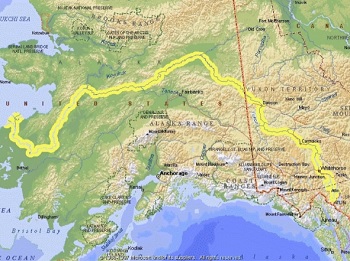
New study proposes to uncover where chinook salmon could be dying en route to Yukon
The state of Alaska is proposing new research to track dwindling chinook salmon numbers this spring, and it’s possible the study could eventually extend into the Yukon. This week, members of the bilateral Yukon River Panel met in Anchorage, Alaska, to brainstorm ways to help the salmon, which undertake one of the longest salmon migrations in the world. It’s during this migration, though, that tens of thousands of salmon seem to go missing every year. >click to read< 10:23
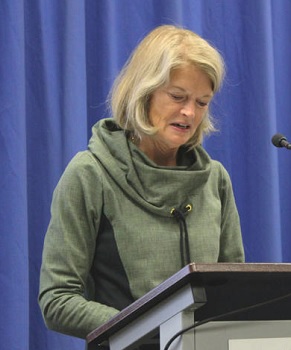
Bycatch stirs debate at fisheries roundtable
Hosted at Kenai Peninsula College by the Kenai River Sportfishing Association, the three-hour event brought together a who’s-who lineup of fisheries and policy experts from Alaska. That lineup included Alaska Department of Fish and Game Commissioner Doug Vincent-Lang, who said Bering Sea trawling is not responsible for Alaska’s declining chinook salmon runs. The Magnuson-Stevens Fishery Conservation and Management Act defines bycatch as fish harvested in a fishery that are not sold or kept for personal use. The phrase is sometimes used generally to refer to the capture of fish that are not being targeted by a specific fishery that are discarded. >click to read< 09:59
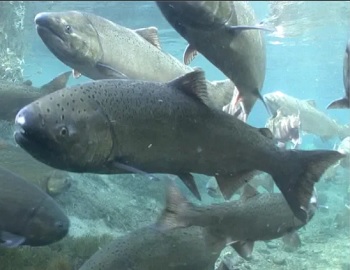
Critics rip feds’ “half-baked” plan to save California salmon
Fishing groups and water suppliers fought the Biden administration’s proposed drought rules for California’s water system, telling a federal judge Friday the emergency plans won’t stop the demise of endangered salmon. The rules call for new water temperature targets and improved collaboration between federal and state officials on the management of California’s two main water conveyance systems. But the Pacific Coast Federation of Fishermen’s Associations and other conservation groups cast the “interim operations plan” as a half-baked measure that will lead to a third consecutive year of salmon die-offs. >click to read< 17:36
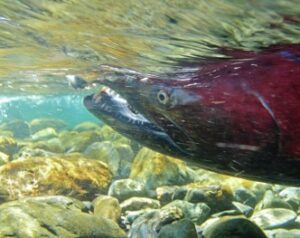
Trawler bycatch debate heats up after dismal 2021 returns
Chinook salmon returns were dismal virtually everywhere in Alaska this year, from Southeast to the Bering Sea, with few exceptions. That follows a trend, as abundance has declined over roughly the last decade. The North Pacific Fishery Management Council is debating changes in its meeting this month. Trawlers, which use weighted nets to drag either along the bottom or in midwater, are permitted a certain amount of bycatch as they fish for their target species, the largest of which is pollock. Bycatch is always a heated issue, but it is especially so now. >click to read< 07:10
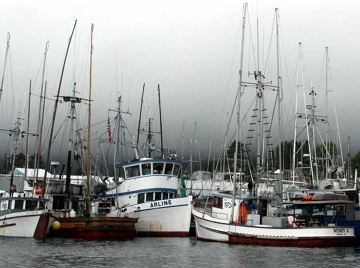
Chinook catch falls short in first Southeast troll opening. Fleet gets a another shot.
Southeast’s commercial troll catch of king salmon fell short of its target in the first summer opening in July. The fleet gets another shot at those chinook in a second fishing period that starts Friday, Aug. 13. The region’s king salmon catch is managed under the Pacific Salmon Treaty between the U.S. and Canada. Commercial trollers had 119,300 fish remaining on this year’s allocation under that agreement going into the summer season. That leaves a target of 53,000 for the second opening. Fish and Game expects it could take seven to 10 days for the fleet to hit that mark. >click to read< 13:33
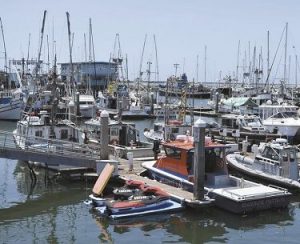
California Fishermen mark a pleasant surprise after preparing for a grim summer. An abundance of fish.
Scott Edson, who fishes out of Half Moon Bay, said this season has been great for everyone, with an abundance of fish in the water not seen in years. “This year is something guys say they haven’t seen in 15 to 20 years. It’s been a pretty good season so far,” Edson said.,,, Don Marshall, who fishes out of Half Moon Bay, said the salmon season had been a lot better than expected, and he had seen more fish than in the last 10 to 15 years. He recently caught 180 salmon totaling around 2,000 pounds, a daily catch worth $13,000 at $6 a pound pricing. “I had the best day I have ever had,,, Nobody expected this many fish, and many fishermen were preparing for a grim summer and other options,” >click to read< 11:17
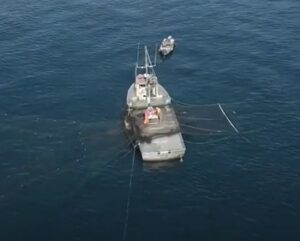
Inland Fisheries: A big fight in Lansing over fishing rules on the Great Lakes
Dana Serafin still hauls in 20,000-pound boatloads of whitefish to supply regional restaurants and markets, Native whitefish, the main livelihood for Serafin and other Great Lakes commercial fishermen, have been in decline for years amid changes to the food web, replaced in Serafin’s nets by healthier populations of walleye and lake trout that he’s not allowed to keep. Chinook salmon, once a favorite of recreational anglers on lakes Michigan and Huron, have also plummeted in Lake Michigan, and all but disappeared from Lake Huron. Battles are brewing over fishing rights from recreational, commercial, Native American, and environmental group meddling. Video, >click to read< 13:41
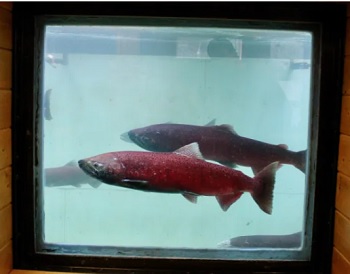
2021 Yukon River Chinook salmon run will likely be small, according to forecast
Somewhere between 42,000 and 77,000 Canadian-origin fish are anticipated to make the journey from the Bering Sea this year, Alaska and Yukon experts told attendees during the Yukon River Panel’s pre-season meeting on Tuesday. The most likely run size would be 57,000, they said. That’s smaller than the pre season outlooks for 2020 and 2019, and both those years ended disastrously when it came to getting enough salmon across the border. Under an international treaty, Canada and the U.S. are supposed to work together to ensure at least 42,500 fish make it to their spawning waters in Yukon. That spawning escapement goal hasn’t been met since 2018, last year only about 33,000 Chinook made it. >click to read< 13:21

Declining salmon runs to restrict 2021 commercial season
During a press briefing on Friday morning, John McManus President of the Golden State Salmon Association said the added restrictions will deal a blow to commercial fishermen. “You may wonder why we’re in this predicament this year, there are some near term and some longer-term reasons why but at the end of the day, we’re seeing a decline in our salmon runs here in the state of California,”,,, Joe Conte said his biggest concern is losing more of his fleet. “I saw a lot of guys just kind of hang it up during crab season, a lot of guys saying they were gonna see how salmon turned out before they made some life decisions,” >click to read< 09:55
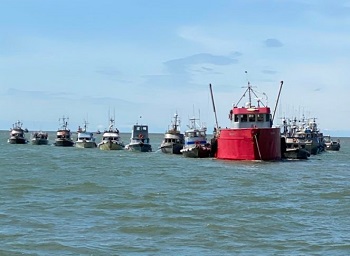
2020 commercial salmon catch, and value took a dive
Commercial salmon harvests proved challenging for the 2020 season, challenged by a global pandemic of the novel coronavirus, with the overall fish catch and its value down considerably from a year earlier. Data released on Monday, Nov. 9 by the Alaska Department of Fish and Game, said the all species harvest has an approximate value of $295.2 million, down 56 percent from $673.4 million in 2019. Fishermen delivered some 116.8 million fish, a 44 percent drop from the 208.3 harvested a year earlier, the report said. >click to read< 18:15
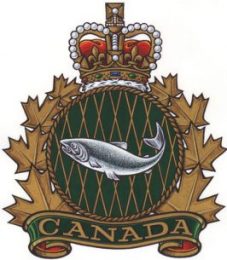
Government of Canada takes action to address threats to struggling Fraser River Chinook
Today, (June 19, 2020) Fisheries and Oceans Canada is releasing 2020 Fisheries management measures that will support the recovery of at-risk Fraser River Chinook populations, as well as protect the jobs and communities that depend on Chinook. The 2020 measures include additional restrictions to strengthen conservation as well as the flexibility needed where impacts to stocks of concern will be very low. These measures were developed following consultation with Indigenous communities, recreational and commercial fishing organizations, and environmental organizations. These measures are one component of a larger strategy intended to place at-risk Pacific salmon populations on a path towards sustainability. >click to read< 11:49
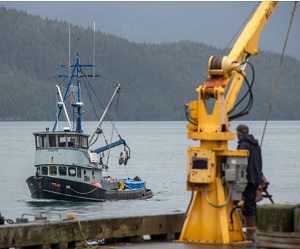
Copper River fishermen gain another harvest
Commercial harvesters keen on those Copper River salmon got a fifth shot at those prized Chinooks and reds on Thursday, June 18, in a 12-hour opener announced by Alaska Department of Fish and Game officials in Cordova. Waters within the expanded Chinook salmon inside closure area were closed for the period. It has been, in no uncertain terms a real slow start, with several of those openers already cancelled because of a very slow run. Through Tuesday, June 16, a total of 1,665 deliveries to processors from four 12-hour openers in the Copper River had brought in some 5,751 kings, 71,370 sockeyes and 1,056 chums, a total of 78,177 fish. >click to read< 16:01

Judge weighs shutting down Southeast Alaska Chinook fishery
Fishermen in Southeast Alaska could see their season cut short if a federal judge issues an injunction requested by a Washington environmental group to protect the food supply of a subpopulation of orcas. The Wild Fish Conservancy filed a lawsuit against NOAA,,, “We are getting blamed for harvesting their food source, which really isn’t the cause of the problem,” Amy Daughery, executive director of the Alaska Trollers Association said. “The problem as we see it, is the exponential population growth in Seattle, which has lead to a lot of toxicity and pollution and habitat loss in that area. And so these whales are really struggling, this one population. The Northern killer whales that we see off the coast of Southeast Alaska are doing very well. In fact they’ve increased.” >click to read< 10:19
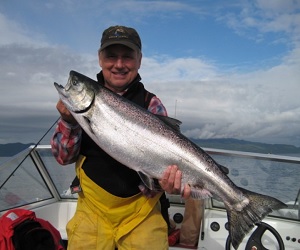
Destroying a fishery will not save Southern Resident Killer Whales – Scientists say feed starving whales farmed salmon
In less than two weeks, a Seattle-based federal judge will decide the fate of some 1,600 Southeast Alaska salmon trollers—fishermen who are already looking at the lowest allotment of Chinook in 20 years, largely due to the past three Pacific Salmon Treaty agreements that have cut, by two-thirds, their allocation of these high-value, sought-after fish. If you haven’t been following the trade press or Alaska media in the past few weeks, you may not know that this group of largely rural Alaska fishermen are today facing the unthinkable: being put out of business—collateral damage as the result of a lawsuit filed by a Washington state-based NGO, the Wild Fish Conservancy (WFC), against the National Marine Fisheries Service (NMFS). In the lawsuit, WFC seeks a Preliminary Injunction to stop the Southeast Alaska summer troll fishery, alleging that NMFS has failed to allow enough king (Chinook) salmon to return to Puget Sound to feed endangered Southern Resident Killer Whales,,, >click to read< 08:16
Feed starving whales farmed salmon, say scientists – “You could use well boats to deliver the farmed fish to where the whales feed.” >click to read<






